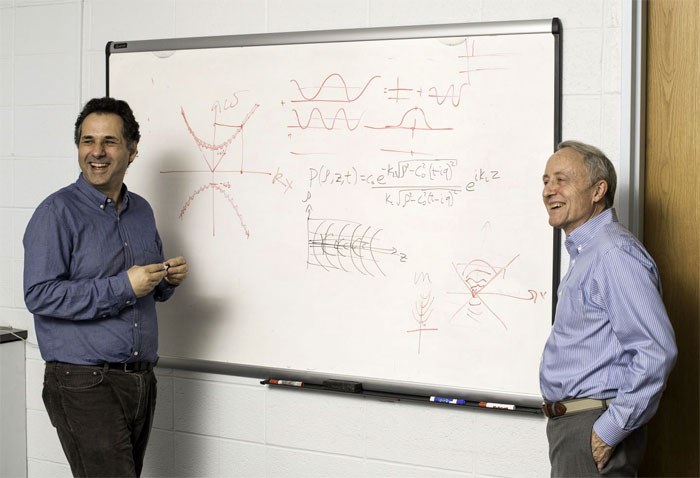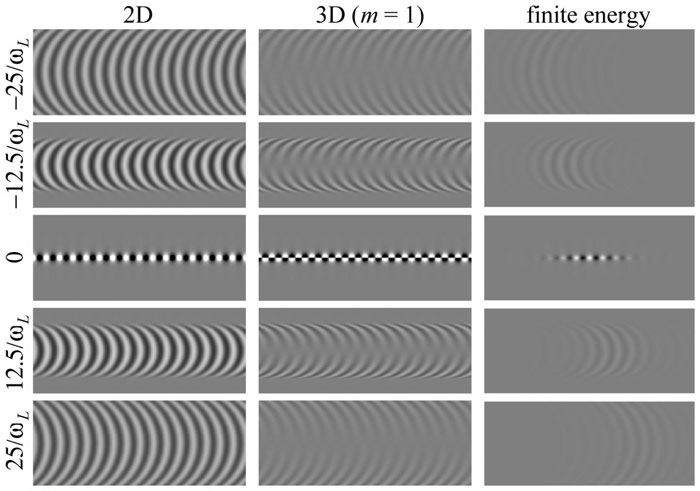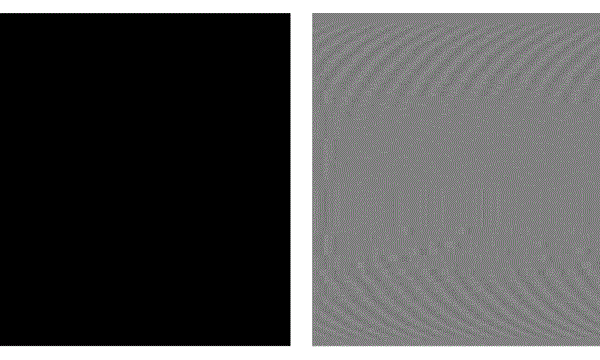The discovery of a thin, intense beam pattern, dubbed the “needle pulse beam,” could have applications ranging from imaging in pulse-echo systems to use in conjunction with nonlinear systems and media. Unlike most traditional beam patterns, which maintain a persistent shape as long as the source is operating, the needle pulse beam is formed by a light or sound wave that collapses inward, narrows for a nanosecond or less, then expands outward again. It is more intense than traditional beam patterns.
“It is very localized, with no extensions or side lobes that would carry energy away from the main beam,” said professor Miguel Alonso, University of Rochester. “Side lobes are the enemy. You want to direct all of your ultrasound wave to the one thing you want to image, so then, whatever is reflected back will tell you about that one thing. If you’re also getting a diffusion of waves elsewhere, it blurs the image.”

At left, Miguel Alonso, professor of optics, and Kevin Parker, the William F. May Professor of Engineering, with the 'analytically beautiful mathematical solution' Alonso devised for the new beam pattern they describe in a recent paper in Optics Express. Courtesy of J. Adam Fenster/University of Rochester.
The idea for the needle pulse beam pattern originated with University of Rochester professor Kevin Parker, an expert on ultrasound. Alonso, an expert on optical theory and mathematics, devised what Parker calls “an analytically beautiful mathematical solution” that could apply to a beam with finite energy.

These are three representations of the 'needle pulse' beam, showing how the circular wavefronts collapse into a needle-like thin power distribution with no side lobes. Courtesy of Kevin Parker/Miguel Alonso.
The researchers studied the properties of pulsed solutions to scalar and vector wave equations composed of plane waves with equal longitudinal spatial frequency. This condition guaranteed that, at all times, the field profile would remain invariant in the longitudinal direction. They demonstrated that, both in two and three dimensions, many closed-form scalar solutions could be found.
The simplest solutions had wavefronts that were close to hemispherical most of the time, with the same radius of curvature, but longitudinally displaced. At a given time, however, they collapsed onto a strongly transversely localized distribution free of the typical Bessel side lobes.
These solutions involved finite power but not finite energy given their infinite longitudinal extent. However, the researchers found that closed-form versions of these solutions carrying a finite amount of energy were possible.

A representation of the ‘needle pulse’ beam, showing how the circular wave fronts collapse into a needle-like thin power distribution with no side lobes. Courtesy of Kevin Parker/Miguel Alonso.
Because it is incredibly narrow, the needle pulse beam “makes it possible to resolve things at exquisite resolutions, where you need to separate tiny things that are close together,” Parker said.
“All the energy fits together in time and space so it comes together — BAM! — like a crescendo,” said Parker. “It can be done with an optical light wave, with ultrasound, radar, sonar — it will work for all of them.”
The beam could have applications not only for ultrasound, radar and sonar, but for microscopy and any form of laser materials processing that involves putting as much light as possible on a given line. Further work is required to make detailed comparisons between needle pulse fields and other commonly used pulses with some form of propagation invariance.
“Finding a new beam pattern is like finding a new element. It doesn’t happen very often,” said Parker.
The research was published in Optics Express, a journal of OSA, the Optical Society of America (doi: 10.1364/OE.24.028669).